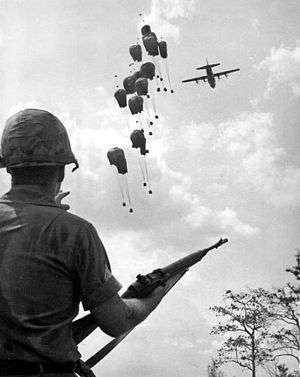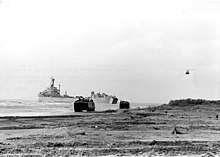1967 in the Vietnam War
| 1967 in the Vietnam War | |||
|---|---|---|---|
 Air drop of supplies in Operation Junction City | |||
| |||
| Belligerents | |||
|
Anti-Communist forces: |
Communist forces: | ||
| Strength | |||
|
South Vietnam ARVN: 798,800 [1] | |||
| Casualties and losses | |||
|
US: 11,153 killed South Vietnam: 12,716 killed[2] Allies: Unknown |
US Sources North Vietnam: 140,000 casualties [3] (Likely Inflated) | ||
January
- January 6, 1967
Operation Deckhouse Five was conducted by the United States Marine Corps (USMC) and South Vietnamese Marine Corps forces along the Mekong River Delta. The operation was notable in that it was a sizable, combined USMC and Vietnamese Marine amphibious operation and it was the last Special Landing Force (SLF) amphibious landing to take place beyond the boundaries of I Corps. The operation occurred January 6–15, 1967.
- January 8, 1967
Operation Cedar Falls was a military operation conducted primarily by U.S. forces. The aim of this massive search and destroy operation was to eradicate the so-called "Iron Triangle", an area located in close proximity to Saigon which had become a major stronghold of the Viet Cong. The operation began on January 8, 1967, and ended on January 28, 1967.[4]
 Two U.S. Marine Corps amphibious tractors are moving along the beach in the foreground, with a UH-1 helicopter approaching at right. USS Washtenaw County (LST-1166) is in the background during Operation Deckhouse Five.
Two U.S. Marine Corps amphibious tractors are moving along the beach in the foreground, with a UH-1 helicopter approaching at right. USS Washtenaw County (LST-1166) is in the background during Operation Deckhouse Five.
February
- February 14, 1967
The Battle of Tra Binh Dong was probably the most famous battle fought by the South Korean Marines. It was fought in the Tra Binh Dong village near the border of Cambodia.
- February 17, 1967
Operation Bribie, or the Battle of Ap My An, was fought in Phước Tuy Province between Australian forces from the 6th Battalion, Royal Australian Regiment (6RAR) and the Viet Cong, reinforced by North Vietnamese Army (PAVN) regulars.
- February 22, 1967
Operation Junction City was an 82-day military operation conducted by United States and Republic of Vietnam (RVN or South Vietnam) forces begun on February 22, 1967, lasting until May 14, 1967. It was the largest U.S. airborne operation since Operation Market Garden during World War II, the only major airborne operation of the Vietnam War, and one of the largest U.S. operations of the Vietnam War.[4]
April
- April 21
Operation Union was a search and destroy mission in the Que Son Valley carried out by the 1st Marine Regiment to engage the PAVN 2nd Division. Launched on April 21, 1967, the operation ended May 16.[4]
From April to May 1967 The Hill Fights was a battle between the PAVN and USMC on Hills 881 North, 881 South, and 861 north of Khe Sanh Combat Base in the I Corps Tactical Zone.
May
- May 11, 1967
Running from May 11 to 1 July 1967 Operation Malheur I and Operation Malheur II were a series of military actions conducted by the United States Army subduing increased activity by Vietcong forces in the northern part of South Vietnam.
Operation Union II was a search and destroy mission in the Que Son Valley carried out by the 5th Marine Regiment. Launched on May 25, 1967, the operation ended June 5.[4]
July
- July 2, 1967
Running from July 2 to July 14, 1967 Operation Buffalo was a major operation that took place in the southern half of the DMZ, northeast of Con Thien.[4] On 2 July the PAVN 90th Regiment ambushed the 1st Battalion 9th Marines, the Marines suffered 84 killed, 190 wounded and 9 missing making this the worst one-day loss for the Marines in Vietnam.
- July 9, 1967
Operation Hong Kil Dong was the largest South Korean operation of the Vietnam War to halt infiltration into friendly areas.
September
- September 4, 1967
Operation Swift was a search and destroy mission in the Que Son Valley carried out by the 1st Marine Division. Launched on September 4, 1967, the ensuing battles killed 114 Americans and an estimated 376 PAVN. The operation ended September 15.[4]
- September 19
The Royal Thai Army Regiment starts its deployment in South Vietnam.[5]
October
- October 10–20, 1967
Operation Medina was a search and destroy operation conducted in the Hai Lang Forest Reserve of South Vietnam.
- October 17, 1967
The Battle of Ong Thanh saw the soldiers of the 2nd Battalion, 28th Infantry (the "Black Lions"), ambushed by a well-entrenched and prepared Viet Cong regiment outnumbering the Americans almost 10-to-1.U.s. losses were 64 killed, 2 missing and 75 wounded
- October–November
The first battle of Loc Ninh was fought by the Vietcong and the CIDG, and ended when ARVN and US forces relieved the camp. Viet Cong losses were 850-1000 killed
November
.jpg)
- November 3–22, 1967
The Battle of Đắk Tô was a series of major engagements that took place in Kon Tum Province, in the Central Highlands of South Vietnam. U.S. losses were 361 killed and 15 missing, ARVN losses were 73 killed and 18 missing and PAVN losses were estimated at 1000-1664.
- November 11, 1967
Operation Wheeler/Wallowa commenced in Hiep Duc-Que Son Valley and continued until February 1968. U.S. losses were 110 killed and 2 missing and PAVN losses were estimated at 865.[6]
December
- December 6–20, 1967
The Battle of Tam Quan was a two-week battle fought when the U.S. 1st Brigade, 1st Cavalry Division and 1st Battalion, 50th Infantry Regiment disrupted the PAVN 22nd Regiment, which was in the process of preparing to conduct a major attack on ARVN installations at Tam Quan.[7]
Year in numbers
| Armed Force | Strength | KIA | Reference | Military costs—1968 | Military costs—2020 | Reference | ||
|---|---|---|---|---|---|---|---|---|
| 798,800 | 12,716 | [1] | ||||||
| 485,600 | 11,153 | [1][8] | ||||||
| 47,830 | [1] | |||||||
| 2220 | [1] | |||||||
| 6820 | [1] | |||||||
| 2020 | [1] | |||||||
| 530 | [1] | |||||||
| 140,000 (casualties) | US Source Estimate[9] |
Bibliography
-
War Remnants Museum Data
Armed Force 1964 1965 1966 1967 1968 1969 1970 1971 1972 
514,000 643,000 735,900 798,800 820,000 897,000 968,000 1,046,250 1,048,00053**553(55((3(5(5minute ththhthntththte digest my nuts 
23,310 180,000 385,300 485,600 549,500 549,500 335,790 158,120 24,000 
200 20,620 25,570 47,830 50,000 48,870 48,540 45,700 36,790 .svg.png)
200 1560 4530 6820 7660 7670 6800 2000 130 
0 20 240 2220 6000 11,570 11,570 6000 40 
20 70 2060 2020 1580 190 70 50 50 
30 120 160 530 520 550 440 100 50 - Clarke, Jeffrey J. (1988), United States Army in Vietnam: Advice and Support: The Final Years, 1965–1973, Washington, D.C: Center of Military History, United States Army, p. 275
- Art, Robert J.; Waltz, Kenneth Neal (2004). The Use of Force: Military Power and International Politics. Rowman & Littlefield. ISBN 9780742525573.
241.
- Stanton 2003, p. 10
- Stanton 2003, p. 272
- Stanton 2003, p. 11
- Chaunac & Duryea 2003, p. 198
- United States 2010
- Art & Waltz 2004, p. 241
- References
- Art, Robert J.; Waltz, Kenneth Neal (2004). The Use of Force: Military Power and International Politics (2004 ed.). https://books.google.ca/books?redir_esc=y&id=o61wPsoCDekC&q=241: Rowman & Littlefield. ISBN 978-0-7425-2557-3.CS1 maint: location (link) Total pages: 483.
- Chaunac, Jacques François de; Duryea, Lyman C. (2003). The American Cavalry in Vietnam: "First Cav" (2003 ed.). Turner Publishing Company. ISBN 978-1-56311-890-6.CS1 maint: ref=harv (link) Total pages: 312.
- Stanton, Shelby L. (2003). Vietnam Order of Battle (2003 ed.). Stackpole Books. ISBN 978-0-8117-0071-9. Total pages: 396.
- United States, Government (2010). "Statistical information about casualties of the Vietnam War". National Archives and Records Administration. Archived from the original on 26 January 2010. Retrieved March 6, 2010.